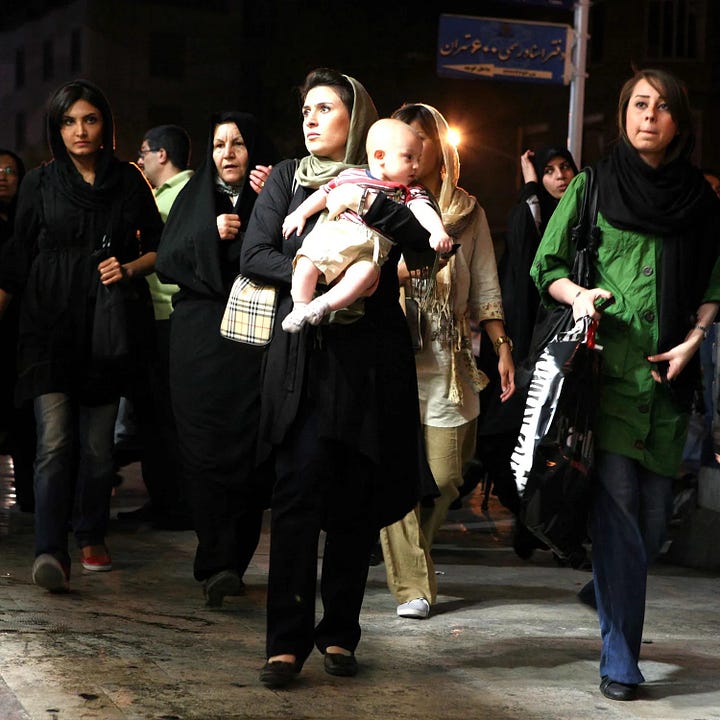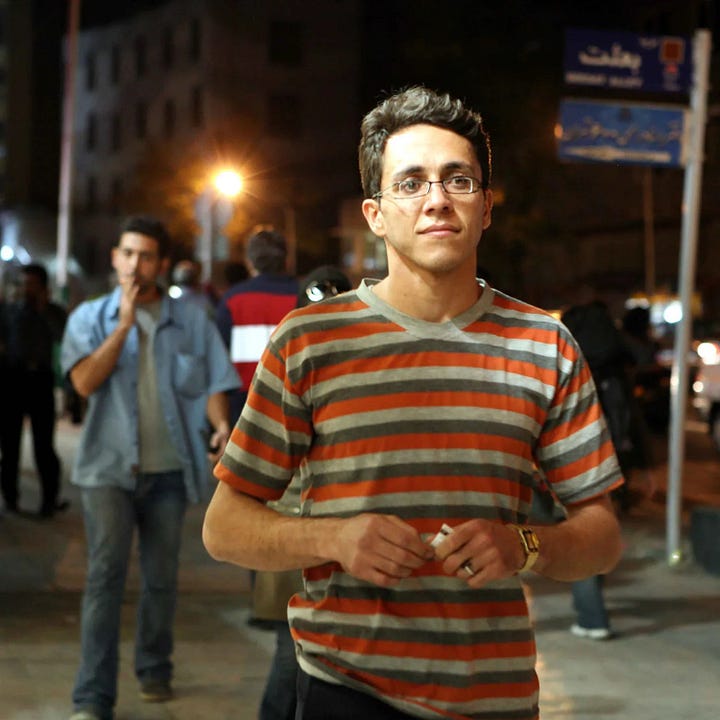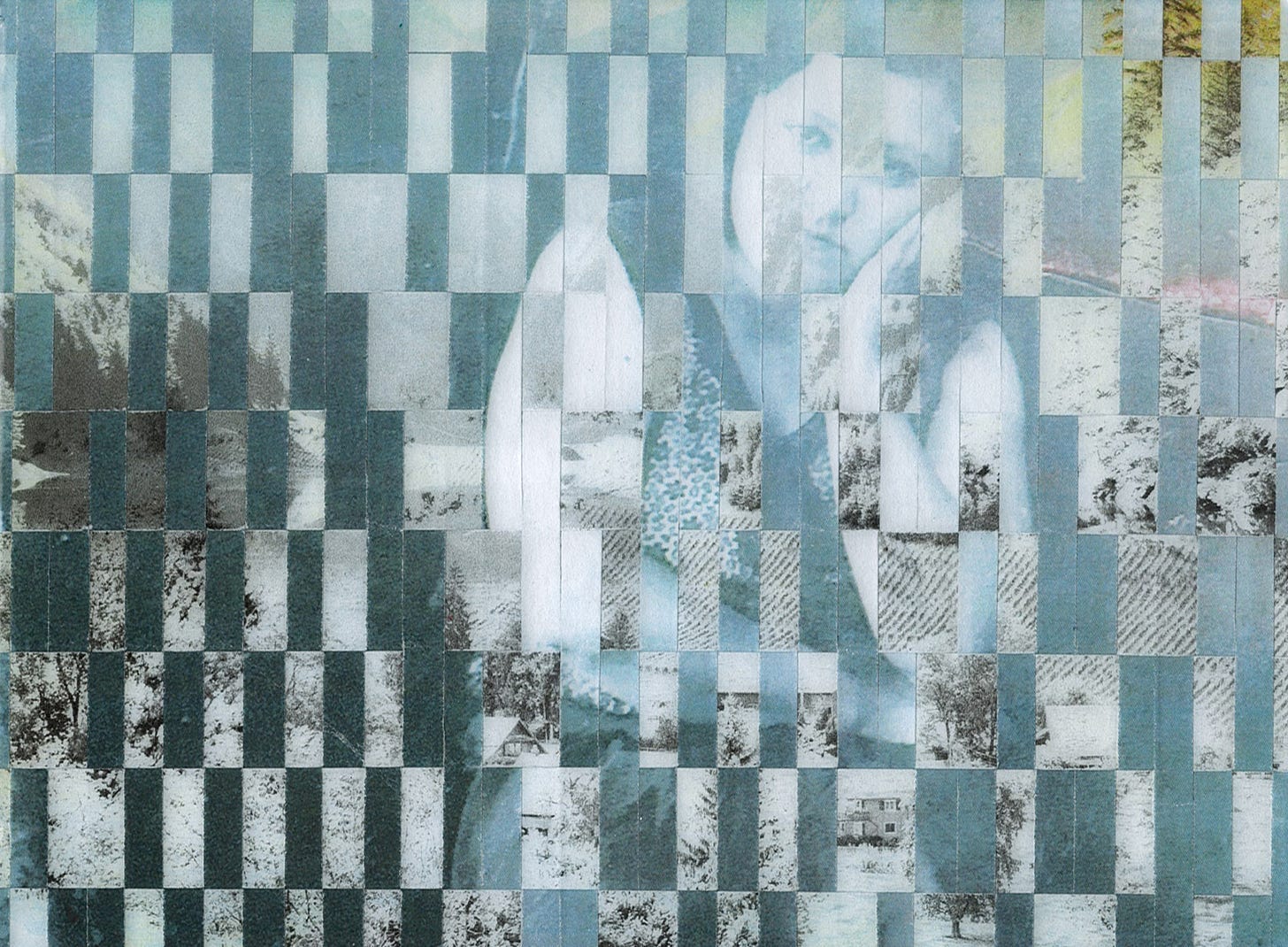I visited the studio of Iranian mixed-media artist Samin Ahmadzadeh in her London home to view her latest work of intricately woven compositions. While there, I discovered that it was impossible to appreciate the depth of her latest work without retracing her footsteps to the start of what has become her decades-long fascination with and investigation into memory, culture, and personal narrative.
Samin Ahmadzadeh’s early series Tehran by Night (circa 2011) features compositionally balanced, well-lit images of people as still life. In Figure 1, a mother is holding her baby, oblivious to the crowd around her in modern-day Tehran. She seems transfixed by an out-of-image light, but her tranquil gaze points to a deeper internal summons. In Figure 2, a young man looks contemplatively outward, as though absorbed in thought.


In both works, the pondering figures are spotlighted in a sea of mid-tones and shadows, reminiscent of Dutch paintings but with a contemporary cinematic flair. They showcase the artist’s desire to capture thought in motion, although the result is a moment where the thinker is captured, even mesmerized, by his or her thoughts.
Over a decade later, one can see that Samin’s early fascination with thought processes was but the seed of what has developed into a textured and intricate body of work where memories of one’s past and culture are more concisely integrated. And so, her latest works immediately beg an inquiry: what do we really remember?
Samin now works predominantly with archival images, her own or others’, and she approaches each image with the curiosity and respect it deserves—a process that also facilitates the discovery of the final composition.
Having given the collection time to breathe, she begins to brush away the sands of time and proceeds with making copies of the archival images with which she makes a plain weave miniature of an initial composition. However, she also allows the weaving process to reveal more. When she’s decided on the final composition, she begins the process of interlacing strips of the reproduced images. Once the final woven piece is complete, she carefully attaches the whole woven paper, soaked, to birch wood—the hardest part of the process. She then lacquers the composition and board to set the image in time and space.
The interweaving process of her larger pieces such as Figure 3: Ahvaz Garden III (198.5 x 130 cm) is made up of fifty-six individual panels and can take up to two years to make.
The arrangement of visual elements in Ahvaz Garden III creates a surprising, dynamic flow that captures the eye—as though gazing at a glossy pixelated flatscreen displaying someone else’s memories—while the interplay of textures adds depth. The final piece, a juxtaposition of smooth, glossy finish over woven surfaces, draws the viewer in and invites tactile exploration. You want to touch this masterfully crafted composition!
To date, her finished pieces include the Memento series. Shown here are Memento 1 (59 x 84 cm); Memento 2 (59 x 84 cm), Memento 4 (19 x 17.5 cm), and Memento 5 (14 x 9.5 cm). It’s a series of muted works in neutral tones, as one might remember an event or person from the past. But each has a hue that carries its own emotional weight, contributing to the overall sentiment of the series.
The tones enhance the conceptual theme: warm greys mingle with blacks and whites, creating a harmonious and balanced palette. Importantly, the back-and-forth warm and cool tones heighten the emotional impact of her art, further engaging the viewer with her unique and powerful artistic vision. Through this synthesis, Samin captures the essence of memory woven together as fragments of experiences and emotions entwined in a vibrant tapestry.
Samin delves deeper into personal identity in her individual works, such as in Figure 8: 65 years (16.4 x 22.3 cm) and Figure 9: Sisters IV (18.5 x 26 x 1.8 cm). The images evoke a sense of nostalgia, inviting viewers to reflect upon their own personal narratives. The blue tone of Figure 10: Azam (16.5 x 12.2 x 1.8 cm) conjures a sense of yearning to go back in time to what was, perhaps to where one once lived, and how the land shapes identity.
The Persian-inspired patterning adds further depth to the works’ cultural richness and historical resonance. The geometric forms and intricate designs, reminiscent of Islamic architectural elements, guide the work, instilling not only a sense of aesthetic balance and rhythm in her compositions but also gives order to the mosaic of haphazard personal narratives.
Placed within the history of art, Samin’s work draws to mind the specific artform of Khatam-kari tradition, also called marquetry, popular in the 18th and 19th centuries in the Royal Courts of Persia, when the artform was elevated to a craft on par with music and painting. Khatam means encrustation, Khatam-kari means encrustation-work. The artform required different materials for artists to assemble into harmonious patterns that would then be laid on a block of wood and lacquered for durability.
Samin’s work might have its historical roots in Persia, but it very much resonates with the age in which we live. Each crossing pattern mimics a pixel, several of which give the composition a pixelated effect—a key characteristic of digital imagery—symbolizing the fragmentation and preservation of memories. The artist’s use of heart-and-soul archival images results in a highly personal blend of past and present, traditional and contemporary, all reflecting a unique perspective on the intersection of memory and identity.
Technology has undeniably influenced our preservation of memory. It has provided us with the tools to store, share, and revisit our personal histories with unprecedented ease. Digital photographs, social media, and online archives serve as a collective memory bank, accessible at the click of a button. However, this constant accessibility and volume can sometimes lead to overwhelm, potentially diluting the significance of individual memories. The digital realm, therefore, offers a double-edged sword; while it makes memory preservation more convenient, it also prompts us to discard the digitally stored memories because we know they are there.
In contrast, Samin’s careful handling and weaving of archival collections elevates memory, inspiring conversation about the preservation of memory, and the intersection of past and present in the construction of identity.
The artist's distinct weaving technique sets her work apart, calling forth a sense of digitized memory through the use of real-world materials. Similar to artists like Dinh Q Le, who also incorporates weaving techniques in his art, Samin brings her own unique perspective and style to the medium.
Her works, a visual feast, spark introspection and connect us to our collective human experience. As we unravel the threads of our memories, we find ourselves woven into the very fabric of their expression. Delving even deeper into the labyrinth of Samin’s artistry, the symbolism becomes more apparent, almost like a whisper growing into an insistent drumbeat.
Her works embody recurring motifs that are far more than mere ornamentation—each strip woven into the tapestry symbolizes a fragment of identity, meticulously arranged and rearranged, mirroring our struggle to preserve, distort, or erase our own past as we explore the paradox of memory. In short, the work seems to express humanity’s long-standing grapple between authenticity, memory, and identity. The methodical weaving technique, the chosen materials, and the works’ overall durability stand together as a silent yearning for a simpler, slower time, for an era untouched by the invasive tendrils of the online world.
And so, in viewing Samin’s latest body of work, we find ourselves caught in the crossfire of tradition and technology, the tangible and the digital—a potent commentary on how we preserve and shape our personal recollections in the digital age.
Samin Ahmadzadeh is represented by Klompching Gallery, NY. Her work is collected internationally and has been exhibited in America, Iran, UK, France, the Netherlands, and Spain.
Samin Ahmadzadeh’s website: samin-ahmadzadeh.com
Samin’s Instagram: https://www.instagram.com/samin_ahmadzadeh/









I love the two photos at the beginning of the article. They are so "real," it's almost like we're standing next to the people in them. The other works are equally amazing. Something about the way they are arranged/created heightens the sense of nostalgia and also the "fractured" way we (or should I say "I") tend to remember things as time passes. Here the holes in the memories are somewhat built in, so to speak, which is how memories often work for me. Lovely!